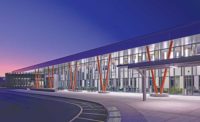Heading into the COVID-19 pandemic, nearly $30 billion of revenue performed and billed in 2019 provided a parachute for the 76 firms taking part in this year’s ENR MidAtlantic Top Contractors survey.
Revenue reported by the largest 70 firms in Delaware, Maryland, Pennsylvania, Virginia, West Virginia and the District of Columbia represented a 5.4% increase over the total posted by a similar set of 70 firms ranked last year.
This year’s top 10 firms outperformed last year’s group, posting a combined 8.1% revenue increase, to $14.7 billion. Whiting-Turner Contracting Co.—with a 17.3% revenue increase, to $3.075 billion—claimed the top spot on the list for the second straight year. Clark Construction Group placed second, with flat revenue of $2.62 billion. HITT Contracting Inc. was third, achieving a 21.4% increase, to $1.74 billion.
Leaders from several contractors across the region helped ENR MidAtlantic better comprehend the current construction landscape and outlook. Those who emailed responses were from Clark; Skanska USA, No. 18, with $432.79 million in revenue; Wohlsen Construction Co., No. 20, with $421.93 million; and Hourigan, No. 29, with $335.37 million. Responses have been edited for space and clarity.
|
Related Link |
What sectors are currently strong?
Brian Abt, division CEO, MidAtlantic region, Clark Construction Group: We see continued opportunity in the health care, government, transit-oriented development, mixed-use and build-to-suit office sectors. In particular, our local health care portfolio continues to expand with a variety of active projects for local health systems.
Todd Donaldson, president, construction, Hourigan: Health care is our largest sector right now. We are grateful for clients continuing their projects and starting new ones despite the challenges their industry is facing.… Multifamily has taken off in 2020. We are seeing increased opportunities to partner with developers looking to capitalize on lower interest rates and a strong demand for housing.
What sectors have cooled down?
Donaldson: The pandemic has brought to light questions about the future of the workplace and open office environments that had previously been popular for attracting talent. This may yield renovation opportunities throughout the region, and we are working hard to stay in front of the trends in this space.
Michael B. Funck, senior vice president, Wohlsen Construction Co.: Certainly, the hotel and entertainment market was already at a peak point and will be impacted for some time to come.
Greg Peele, general manager and executive vice president, Skanska USA: Higher-education clients are grappling with disruptions to their budgets as students plan for a gap year in anticipation of distance-only learning and international student enrollment declines.
What key innovations have helped your firm boost productivity or deal with the COVID-19 pandemic?
Abt: We are proud to have revamped our nationally recognized Summer Associate Program into a hybrid virtual and onsite experience for 185 college students without compromising their safety or professional development.
Funck: We continue to see prefabrication as something that has and will continue to increase its impact on construction. The use of 360-degree cameras has also helped in documenting projects and assisting with inspections during the COVID-19 crisis.
Peele: Incorporating additional VR tools into our building information modeling processes has been an impressive accelerator of the design process that may permanently change our approach to concept design. This, along with our proprietary metrics programs, allows our teams to look at design options and cost ratios at a very detailed level based on function and square footage of a space. We can tell clients with a high degree of accuracy what the financial impact of specific design decisions will be nearly in real time. This has been extremely helpful in the current situation as many of our clients are exploring changes to promote social distancing or allow for more flexibility in space allocations.
Where do you see the industry headed in the next year?
Abt: While we know that COVID-19 has affected the broader workforce, the marketplace from a craftworker standpoint remains strong. There may be an opportunity to attract workers impacted by layoffs in other industries to construction, thereby reducing the labor shortage that our industry has experienced over the past several years.
Donaldson: One of the most exciting trends we are seeing is the utilization of cross-laminated timber (CLT) as private development groups across each market express interest in evaluating this innovative building material. We are currently working on the largest CLT project in the MidAtlantic.
Funck: We have a number of projects which have been postponed to 2021; the amount of opportunities has been greatly reduced. Further, some clients that are trying to get their projects started are having trouble with banks willing to move forward with financing. So, we believe the impacts of the next 18 months will have a [major influence] across our geographical markets and market sectors. These adjustments could [result in] up to 25% less revenue.
Peele: One of the legacies of this period of rapid change has been a reemphasis on flexibility in building design. Institutions are using more prefabricated materials for fast provisional changes to their existing floor plans or adding freestanding modular units for increased surge capacity. Many of our health care clients have quickly implemented plans to convert space within their facilities to meet current needs—establishing decontamination zones and screening areas, converting ambulatory care floors to ICU beds, reimagining traffic flow to allow social distancing and isolation of infected patients and rapidly adopting or expanding telehealth capabilities.







Post a comment to this article
Report Abusive Comment